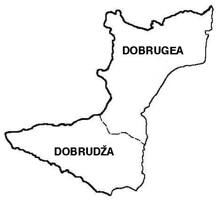
|
The Society of Folk Dance Historians (SFDH) Dobruja
[
Home |
About |
Encyclopedia | CLICK IMAGE TO ENLARGE |

|
Information: A region.
The region of Dobrudža (Bulgaria) and Dobrogea (Romania), collectively known as Dobruja, is a historical region in the Balkans that has been divided since the 19th century between the countries of Bulgaria and Romania. It is situated between the lower Danube River and the Black Sea, and includes the Danube Delta, Romanian coast, and the northernmost part of the Bulgarian coast. The territory of Dobruja is made up of Northern Dobruja, which is part of Romania, and Southern Dobruja, which is part of Bulgaria.
The territory of the Romanian region Dobrogea is organised as the counties of Constanța and Tulcea. The Bulgarian region Dobrudža is divided among the administrative regions of Dobrich and Silistra; the following villages of Razgrad Province: Konevo, Rainino, Terter and Madrevo; and the village General Kantardzhievo (Varna).
The territory of Dobruja has been inhabited by humans since Middle and Upper Paleolithic. Paleolithic people made tools of silex (any of various forms of ground stone) and ate fruits, fish, and other hunted animals. In this period fire was discovered, and at its end the bow with arrows and the boat sculpted of a trunk tree were invented.
After the 1878 war, the Treaty of San Stefano awarded Dobruja to Russia and the newly established Principality of Bulgaria. The northern portion, held by Russia, was ceded to Romania in exchange for Russia obtaining territories in Southern Bessarabia, thereby securing a direct access to the mouths of the Danube. In Northern Dobruja, Romanians were the plurality. The southern portion, held by Bulgaria, was reduced the same year by the Treaty of Berlin. At the advice of the French envoy, a strip of land extended inland from the port of Mangalia (shown orange on the map) was ceded to Romania, since its southwestern corner contained a compact area of ethnic Romanians. The town of Silistra, located at the areas' most southwestern point, remained Bulgarian due to its large Bulgarian population. Romania subsequently tried to occupy the town as well, but in 1879 a new international commission allowed Romania to occupy only the fort Arab Tabia, which overlooked Silistra, but not the town itself.
During World War II, Bulgaria regained Southern Dobruja in the September 1940 Axis-sponsored Treaty of Craiova, despite Romanian negotiators' insistence that Balchik and other towns should remain in Romania. As part of the treaty, the Romanian inhabitants were forced to leave the regained territory, while the Bulgarian minority in the north was expelled to go to Bulgaria in a population exchange. The post-war Paris Peace Treaties of 1947 reaffirmed the 1940 border.
DOCUMENTS
- About Dobrudžanska Rŭka, an article.
- Bulgaria, a country.
- Dobrudžan Dances, an article.
- Romania, a country.
This page © 2018 by Ron Houston.
Please do not copy any part of this page without including this copyright notice.
Please do not copy small portions out of context.
Please do not copy large portions without permission from Ron Houston.